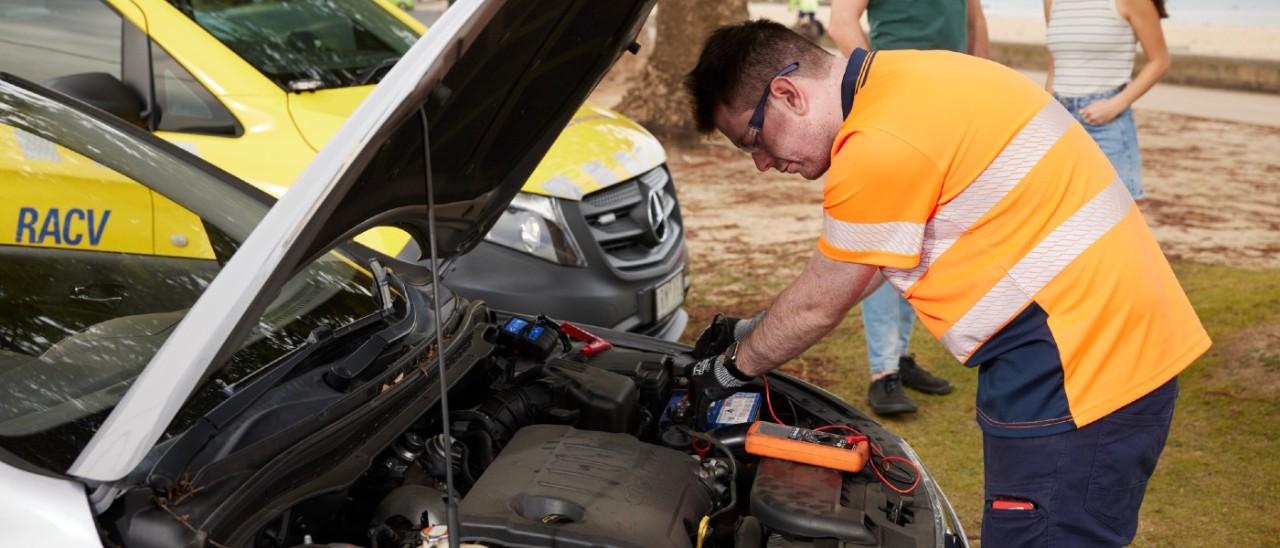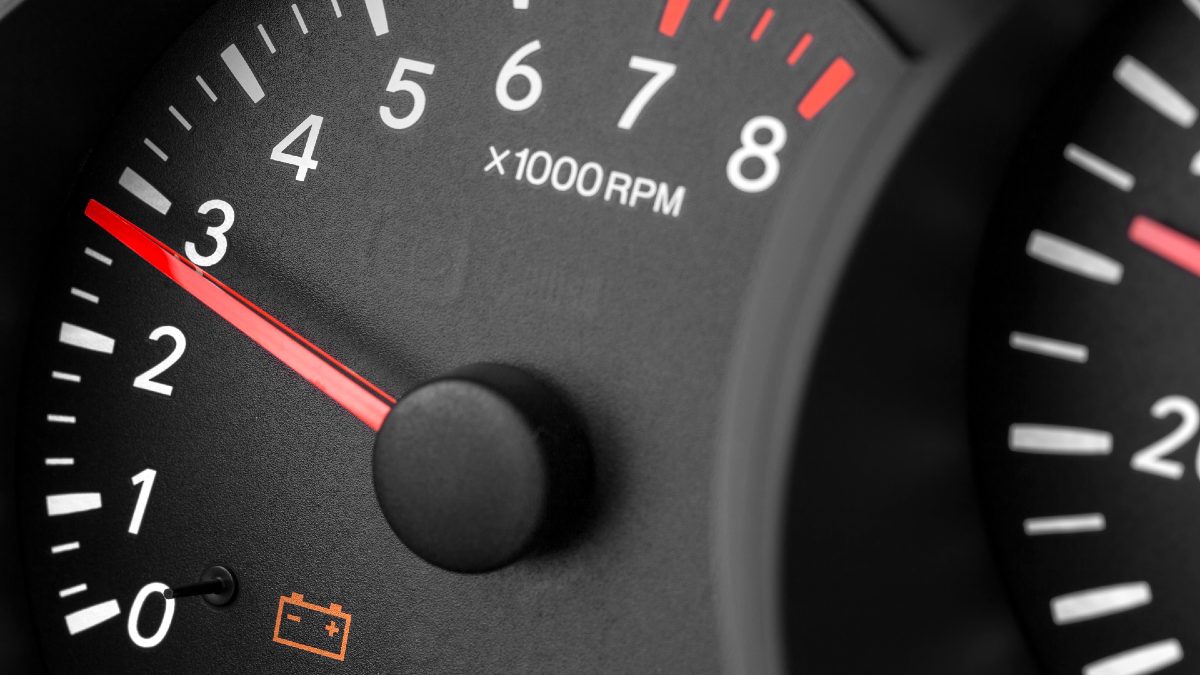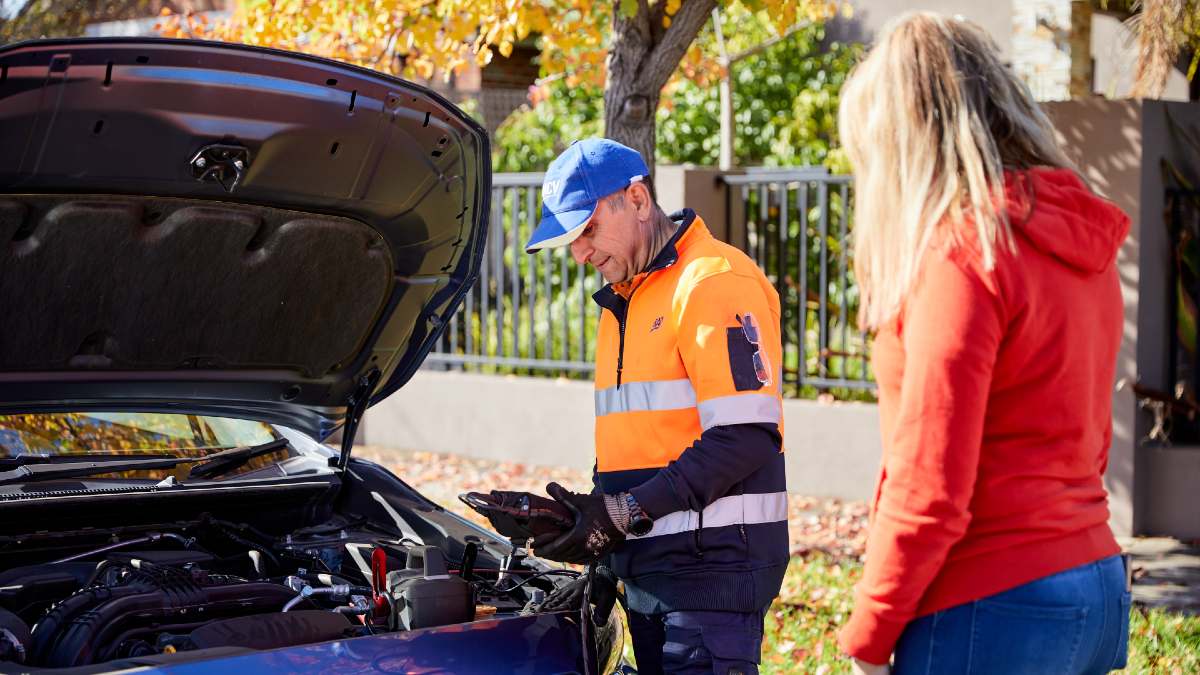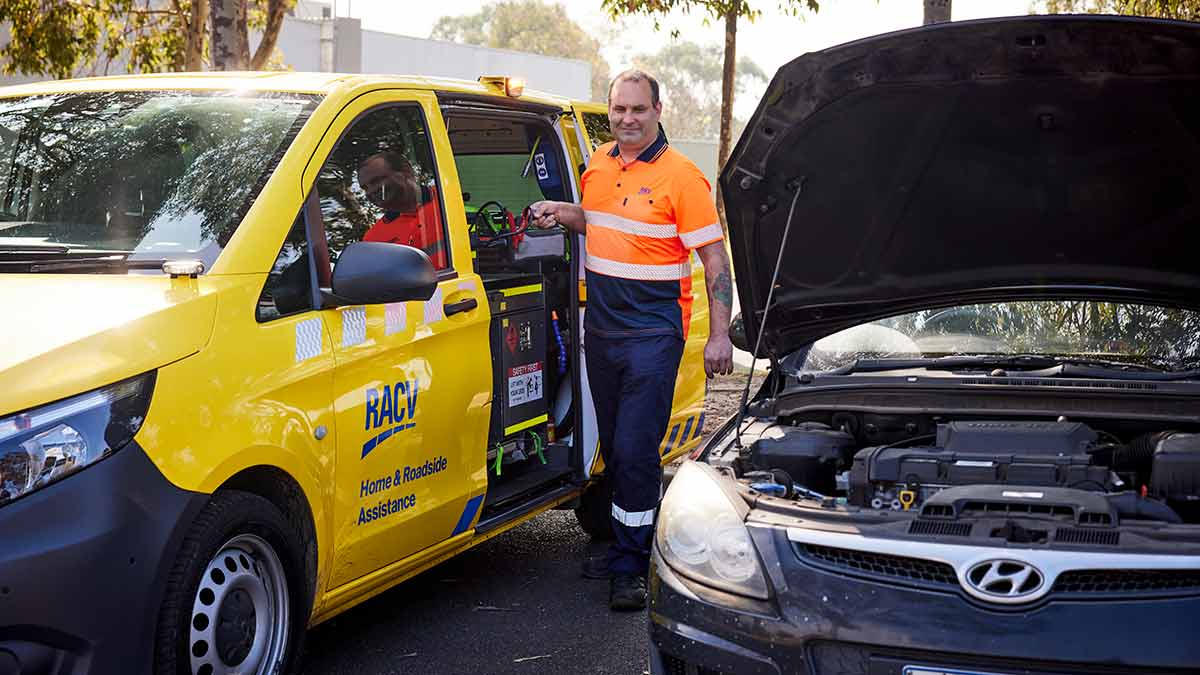Keep your car in tip-top shape during winter cold weather. Vehicle maintenance is especially important in winter as inclement weather like cold temperatures, wind, ice, sleet, and snow become more common.
Car battery guide: how do they work, when to replace, and jump starting

Find out everything you need to know about car batteries, from how to avoid draining the battery to how to jump-start your car and more.
Battery failure is a common cause of car breakdowns. RACV Emergency Roadside Assistance attended more than 280,000 callouts in Victoria for car batteries in 2024. A failing starter battery in a petrol or diesel vehicle might leave you stranded in the driveway or on the road.
"RACV has seen an increase in car battery related breakdowns year on year, so it is worth reading up on car battery care," says RACV General Manager Automotive Services Makarla Cole.
Learn how to prevent your battery from going flat, jump-start a flat car battery without adversely affecting the electrical systems, and more with this handy guide.
More: What you need to know about EV batteries
Want to learn more about car maintenance?
Everything you need to know about your car battery
What does a car battery do?
Car batteries are responsible for starting your car and powering your vehicle's lights and other accessories, like phone chargers, infotainment screens, parking cameras and heated seats.
In internal combustion engine (ICE) vehicles - those that use petrol or diesel - the car battery provides the initial jolt of electricity needed to start the engine. Once the car is running, the alternator takes over to charge the battery and power the electrical systems. If the battery is flat, your car won't start.
Types of car batteries
Lead-acid batteries (petrol/diesel cars)
For decades, the standard car battery has been the lead-acid type. These consist of lead plates submerged in an acid solution that creates a chemical reaction, generating the power to start your engine.
There are two main varieties:
- Flooded lead-acid batteries - the most affordable and widely available battery type for petrol and diesel cars. Lead-acid car batteries are reliable for most everyday driving needs. However, they are heavier, require more maintenance and can be less durable in extreme heat or cold. They are also not suitable for many modern vehicles, which require an AGM battery to operate.
- Absorbent glass mat (AGM) batteries - more expensive, but they offer faster recharging and greater resilience, with better performance in modern vehicles that use stop-start technology. They are particularly well-suited to newer vehicles with advanced electrical systems or for drivers who do a lot of short trips where the alternator has limited time to recharge the battery.
Hybrid vehicle batteries
Hybrid vehicles usually pair a traditional lead-acid starter battery with a medium-sized lithium-ion (Li-ion) or nickel-metal hydride (NiMH) battery to power the electric motor.
NiMH batteries were commonly used in earlier hybrid vehicles due to their durability and safety. However, they are increasingly being replaced by lithium-ion batteries in newer models. Lithium-ion batteries offer a higher energy density and a longer lifespan, making them more suitable for modern hybrid and electric vehicles.

If the battery light illuminates on your car's dashboard, it signifies a problem with the charging system.
How does a car battery work?
When you turn your car key in the ignition or push the start-stop engine button, you are sending a signal to your car to activate its battery.
Inside lead-acid batteries, there are lead plates submerged in an electrolyte solution (sulfuric acid and water). A chemical reaction between the lead and acid creates electrical energy, stored as direct current (DC). This energy flows to the car's starter motor, allowing it to crank the engine to life. Once the engine is running, your car's alternator sends the electric current back into the battery to maintain its charge. Because the electrolyte is in liquid form, lead-acid batteries need to be kept upright and secure.
AGM batteries, on the other hand, suspend the electrolyte in a fibreglass mat between the plates. This design makes the battery spill-proof, more vibration-resistant, and capable of delivering higher power on demand. AGM batteries also charge faster and are better at supporting modern vehicles with stop-start systems, power-hungry electronics and accessories like heated seats or premium sound systems. AGM battery design means that battery fluid maintenance isn't needed.
How long do car batteries last?
Battery life can vary depending on usage, climate and maintenance. A standard lead-acid battery usually lasts three to five years. An AGM battery generally lasts five to seven years, although sometimes they may not last as long if used with stop-start technology.
RACV battery products come with a warranty of up to three years for vehicles used for private purposes.
Signs your car battery might be failing
Recognising the warning signs of a dying battery can help you avoid being stranded. Look out for:
- slow or hesitant engine cranking
- warning lights on the dashboard
- dim lights, slow windscreen wipers, a silent radio or dead remote locks
- corrosion or swelling around the terminals.
If you notice any of these signs, it's time to have your battery tested by a professional.
How do I check my car battery's charge level?
You don't need to wait until you're stuck to check your battery health. For petrol and diesel vehicles, mechanics and roadside assistance technicians can perform a load test to assess your battery's condition.
You can also purchase a multimeter device from most automotive shops to test your car battery's voltage yourself. To get the most accurate reading, test your battery after your car has been turned off overnight. Set your multimeter to read DC volts and turn the dial to 20, then touch its red probe to the positive (+) terminal and its black probe to the negative (-) terminal on your car battery.
Here's how to make sense of your car battery’s voltage readings:
- 12.6v = 100 per cent (fully charged)
- 12.4v = 75 per cent (charged)
- 12.2v = 50 per cent (discharged/flat)
- 12v = 25 per cent (flat/dying)
- 11.9v = 0 per cent (dead).
Anything under 12.4v is considered discharged: the battery may fail at any point.

Most drivers only realise their car battery has died when their car won't start.
How do I know if my car battery is dead?
Most drivers only realise their car battery has died when they go to turn on their car and it won't start. Your engine may try to crank, in which case you will hear a clicking sound, but it will not come to life.
If your battery is completely dead, jump-starting may be possible. If it happens more than once, a replacement battery is likely needed.
Why has my car battery gone flat?
There are several reasons why your car battery might have gone flat. The most common include:
- End of lifespan – batteries naturally lose capacity over time.
- Leaving your lights or accessories on – forgetting to switch off your headlights, cabin lights or accessories (e.g. dashcams) can quickly drain your battery.
- Only driving short trips – since your battery is charged by the alternator as you drive, short driving distances (under 20 minutes) won't allow for much recharging time.
- Leaving your car parked for a long time – your car uses a small amount of current when the key is not in the ignition; so without the alternator recharging the battery as you drive, the battery will drain over time.
- Extreme temperatures – unusually hot or cold weather can weaken battery performance.
- Faulty parts – issues like battery cable corrosion, loose cables, battery leaks, faulty charging and defective fuses can all shorten your battery's lifespan.
How do I jump start my car?
Safely jump starting your vehicle can restart your car battery, but be aware that incorrectly jump starting your vehicle can cause issues with electrical systems.
Always refer to your car's manual for model-specific instructions. If in doubt, seek professional assistance from a mobile roadside service such as RACV Emergency Roadside Assistance.
- Park another car with a charged battery close by.
- Turn off both cars. Put both in park (for autos) or neutral (for manuals) with the handbrakes on.
- Attach the red jumper cable with one clamp on each battery's positive terminal.
- Attach one clamp on the black cable to the charged battery's negative terminal.
- Attach the other black clamp to a piece of bare, unpainted metal on the car with the dead battery, such as a nut on the engine block. Do not use the dead battery's terminal.
- Start the charged car's engine and wait for one minute.
- Start the discharged car's engine and leave both cars running for several minutes.
- Disconnect the cables in the reverse order you attached them.
- Drive your car for 10-20 minutes to ensure that the charge is retained.
If your battery has deteriorated from corrosion or extreme weather conditions, or simply reached the end of its lifespan, it will quickly run out of charge again. If your battery dies again a short while after being jump-started, it may be time for a new battery. Do not rely on continually jump starting to keep your vehicle on the road.

Call RACV Emergency Roadside Assistance for help jump starting your vehicle.
How do I get a replacement car battery?
For petrol and diesel cars, battery replacement is straightforward, but may require specialist equipment in newer vehicles. Roadside assistance services like RACV Emergency Roadside Assistance can test and replace batteries on the spot.
Which car battery do I need?
The right battery depends on your car type and driving needs. Your best bet is to check your vehicle manufacturer's owner manual and talk to your roadside assistance provider. Installing an incorrect battery in your car can severely damage its electrical system.
If you can't find your owner's manual, you will need to know your battery's group size to ensure that the new battery fits in the vehicle battery case. You can find the group size on your old battery's label: it will be a two-digit number, sometimes followed by a letter. You will also need to check the replacement battery has the correct dimensions and its terminals in the correct position for your car.
Check the manufacture date on any battery you're thinking of purchasing. You should not buy a car battery older than six months from the manufacture date, considering the average battery lifespan is two to six years.
There are several types of car batteries: which variant you should use depends on your vehicle's make and model.

RACV's mobile car battery service is available across greater Melbourne and Geelong.
How to maintain your car battery
With a little care, you can extend the life of your battery. Drive for at least 20 minutes weekly to allow the alternator to recharge. Always avoid leaving accessories running when the engine is off. Keep battery terminals clean and tight, and secure the battery to prevent vibration damage.
Seasonal battery care in Victoria
Victoria's varied climate from hot, dry summers to frosty winters can be tough on car batteries. A few seasonal habits can keep yours in better shape year-round.
During high temperatures, park your car in the shade or use a garage where possible.
During low temperatures (think regional areas like the High Country and cold winter mornings across Victoria), petrol and diesel engines require more power to crank the engine to life. To protect your battery, keep your car garaged overnight if possible. Use a battery maintainer or trickle charger if your vehicle is seldom driven.
Keep an eye on your battery charge: a fully charged lead-acid battery is more resistant to the cold than a partially discharged battery. Look out for a Cold-Cranking Amperage (CCA) rating when buying an automotive battery, which tells you how well the battery performs in cold weather when fully charged. Replacement batteries should always be the same or greater CCA.


